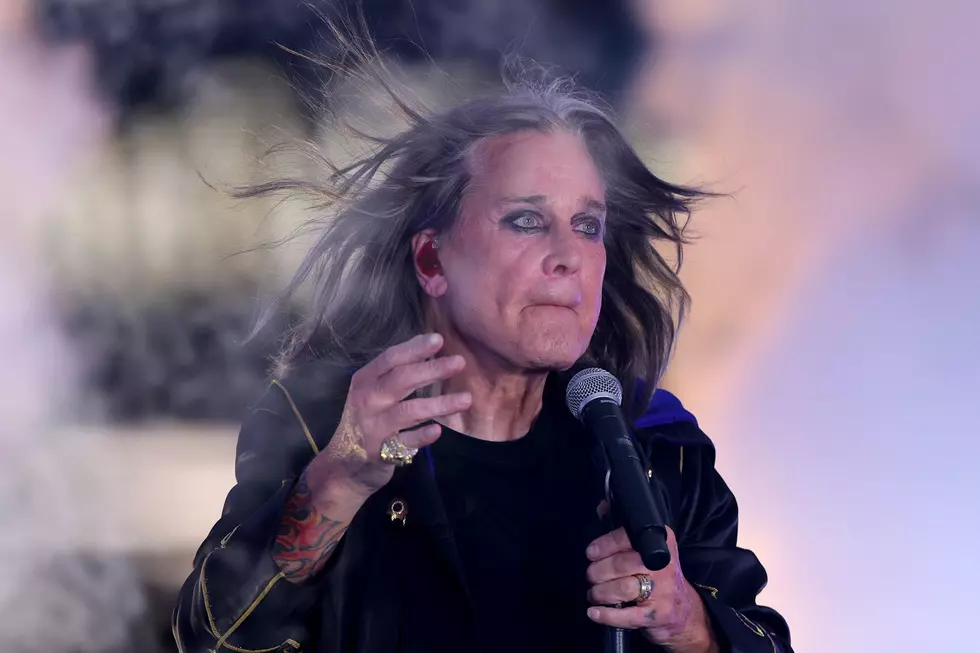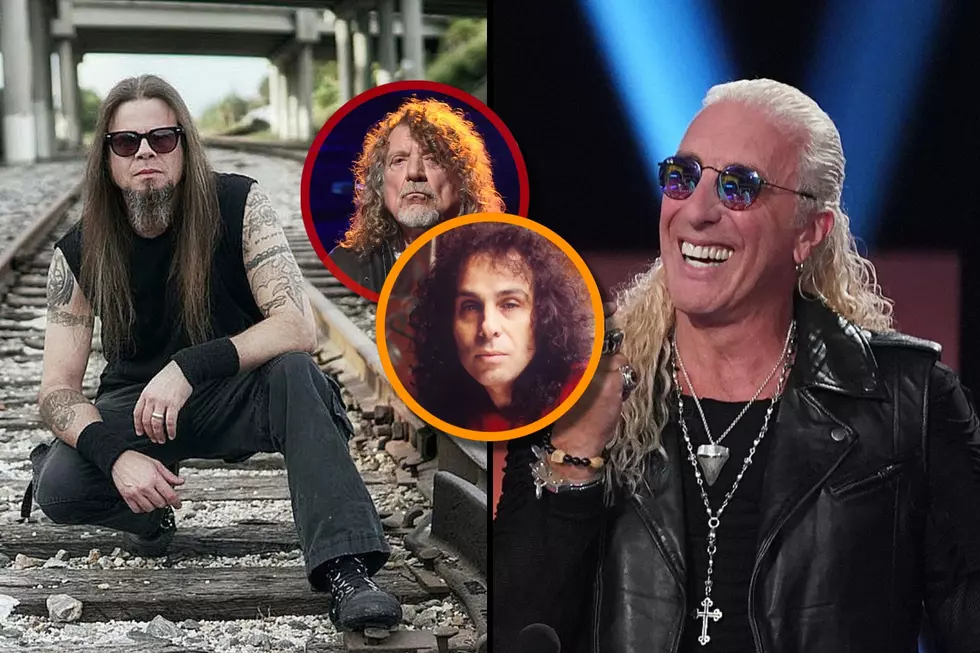
Black Sabbath, 1983-1995: the Good, the Bad and the Awful
The true father of heavy metal shouldn't need defending. Neither should anything that's come from those steel-tipped digits. While his former bandmate, Ozzy Osbourne has lived in the public spotlight, Tony Iommi has remained rather private. He's perferred to let his catalog of music do the talking: Black Sabbath, his solo albums and Heaven and Hell with bassist Geezer Butler, drummer Vinnie Appice and Ronnie James Dio (RIP).
So, without prejudice, let's discuss Tony Iommi and "those" Black Sabbath records. Y'know the ones. We're talking about the albums from the mid-'80s and '90s where the Captain of the Good Ship Black Sabbath carried the Birmingham-bred legacy on his own black leather fringed shoulders.
For the most part, fans of Black Sabbath will draw the line at 1975's Sabotage as the last album that really mattered in the history of heavy metal's first and arguably greatest band. The next two records to feature Ozzy Osbourne on vocals: Technical Ecstasy (1976) and Never Say Die! (1978) are universally shrugged-off as lesser works in the Osbourne cannon. While they're musically ambitious, dabbling in proggy arrangements and synthesizer flourishes, they're weighed down by the sound of a band splintering and losing interest.
Yet, when then-Rainbow vocalist Ronnie James Dio joined for 1980's Heaven & Hell and 1981's Mob Rules, records, Sabbath went on to forge what we know as modern metal. And for a hat-trick they even sprinkled the earliest seeds of speed metal with tracks like "Neon Nights and the titular "Mob Rules." Once again, they defined a genre.
For the next decade Tony Iommi carried on with a revolving cast of band members, releasing eight more records. A lot of these have been panned by critics, ignored by fans and been woefully under-promoted by disinterested record companies. While some of them deserve their critical savaging and commercial failure, some of them yield moments that rank amongst Sabbath's bloody best.
THE GREAT ONE (And A Bit Of Dwarf Abuse...)
Rightfully, the Ian Gillan-fronted Born Again (ESSENTIAL) gets the most respect of any of the first two post-Ronnie records. Opening with "Trashed," a churning slab of hard rock (also Sabbath's only song about drinking – Gillan recounting how he tossed back a few and wrecked Tony's Jag) this one finally seems to be getting its due. Cannibal Corpse has covered "Zero the Hero." Slash freely admits to swiping the riffing from "Zero" for "Paradise City." Lars Ulrich has sung its praises as "one of the best Back Sabbath albums." If you can look past a mix that sounds like it was done in an airplane hanger, Born Again is immensely satisfying. Gillen even wails on "Disturbing the Priests" in the same maddening way Ozzy had done on the Sabs albums of past.
The U.S. tour that Sabbath embarked on to support Born Again did provide the inspiration for Spinal Tap's "Stonehenge." Check out the plethora of footage out there featuring plastecine monuments and dwarves. No shit. The record is good enough to make you overlook such egregious pop culture references.
THE GOOD ONES
Now 1986's Seventh Star (THE SLEEPER) shouldn't necessarily be considered a proper Black Sabbath album. It is, however, a sleeper in the Sabs catalog: a solid mid-'80s hard rock record that has more in common with blues guitarist Gary Moore than anything in Iommi's past. "Heart Like a Wheel" is a rollercoaster ride through several Iommi solos whilst "Turn to Stone" conjures a bit of old Rainbow. "Danger Zone" even touches on AOR. Interestingly, Seventh Star began life as a Tony Iommi solo album and only fell under the Sabs' banner when then-manager and Sharon Osborne's pa, Don Arden, reminded Iommi of his contractual obligations to Warner Bros: the record ultimately appeared under the banner of "Black Sabbath Featuring Tony Iommi".
Another Purple alumni, Glen Hughes, assumes vocal duties on it, doing a fine job on the record but making a bloody mess of the handful of live shows he had gotten through in his drug and alcohol-addled state. By his own admission he was "Sabbath's worst singer." Interestingly, Hughes would re-team with Iommi in the studio as he was searching for a vocalist for his second solo album, 2006's Fused.
"The Shining," lead track from 1987's The Eternal Idol (THE CAREER TURNAROUND) is among the best moments in post-Ozzy Sabbath catalog. The record is doomier, darker and more traditional than the Seventh Star album; it makes sense for Iommi to pick up the Sabbath mantle again. It also marks the debut of vocalist Tony "The Cat" Martin who would become Black Sabbath's longest-serving frontman save Ozzy. For Iommi, who had written the album with then-vocalist (and future Badlands frontman) Ray Gillen, who decided to quit at the beginning of recording to form Blue Murder with John Sykes, The Eternal Idol is testament to perseverance in the face of frustration.
There is one record I will put up there amongst Sabbath's finest: 1989's Headless Cross. (THE UNHAILED CLASSIC) It's first of the band's improbable union with I.R.S. Records (home to R.E.M. and Wall of Voodoo), and the second to feature Tony Martin on vocals, who you can tell isn't holding back the way he did on The Eternal Idol. Martin actually sounds a lot like Dio on this one. Headless Cross harkens back to the riffs of that era with "Devil and Daughter" and "Black Moon:" The doomy vibe of the first records is all over this one. Album closer "Nightwing" is the spiritual heir to "Children of the Sea" but heavier. This is was just one of those records where everything clicked. From Cozy Powell's drumming to long-time Sabbath collaborator Geoff Nicholls' ominous keyboard work, everyone is on the "menace patrol" here.
Reuniting with Dio and the other twin mustache, Geezer Butler was the shot in the arm Iommi needed on 1992's Dehumanizer (A MUST FOR THE DIO FAITHFUL). Everything that was great about the Mob Rules line-up shines through. Dio even sounds a bit edgier here than on his prior Sabs work on the likes of "I" and surprisingly elegiac on "After All." There's even a successful attempt to recapture the energy of "Neon Nights" on "TV Crimes." In fact, some of the material from Dehumanizer became highlights of the live show when Dio, Iommi, Geezer and drummer Vinnie Appice performed years later under the Heaven and Hell banner. This could have actually been a phenomenal punctuation and a new chapter on the post-Ozzy Sabbath legacy except for one sad episode of Dio refusing to open for Ozzy in 1992 when Black Sabbath played with the Oz-man at the Costa Mesa edition of his "No More Tours" (uh, yeah) tour. "Sorry, I have more pride than that," said Dio at the time. St. Rob Halford stepped in that night and did his finest to uphold Sabbath's legacy.
THE BLACK YEARS
Not all of the Sabbath catalog is going to sway the skeptics. Until 1998's live Reunion album with Ozzy, (which yielded two so-so new songs: "Psycho Man" and "Stealing My Soul") the '90s were an era of musical chairs and diminishing returns. Let's call them "The Black Years" for Iommi & Co. With the exception of the track "Jerusalem," 1990's Tyr (FOR FANS ONLY) is pretty unremarkable with Tony Martin's vocals starting to veer a bit uncomfortably into realm of power metal. 1994's Cross Purposes (FORGETTABLE) is very forgettable and the subsequent (and confusingly titled) Cross Purposes Live (ABSOLUTELY UNNECESSARY) album is also fairly unnecessary. Can't win 'em all.
Then there was that one final (and colossal) misstep: 1995's Forbidden (AVOID AT ALL COSTS). It's also the last proper album under the name and shadow of Sabbath. While it pales next to that contemporary monolith of "What the fuck was that?" known as Metallica's Lulu, this wasn't the best note to go out on. The most telling (and shocking) sign of this being a crash-and-burn of a record comes on the production credits: produced by the creative force behind Body Count, Ernie "C." Cunningham. Forget that opener "The Illusion of Power" ties to squeezing a crushing-groove out of Cozy Powell, it sounds like "The Cat" is trying to rap against a crushing Iommi riff when at 2:27 Ice-Muthafuckin'-T.
Said "The Cat" of the whole affair: "We were kinda steered into a 'rap SABBATH' album. Then I was told that [rapper] Ice-T was gonna be doing it and they couldn't or wouldn't tell me if he was doing the whole thing or just one track... and I still didn't know the answer to that when I was in the studio singing the tracks. It has a distinct ill feeling about it."
"Ill" is one way to put it. Licensed or not, you'd think that Black Sabbath has learned a thing or two about working with Hip Hop producers. However, they're about to go at it again with another one – Rick Rubin. Plans for Guru Rick and Tony, The Grand Wizard of The Riff to reunite (3/4ths of) the original line-up have had to overcome more than their share of obstacles: From Iommi's bout with lymphoma (which is now in remission) to an ugly split with founding drummer Bill Ward. Regardless, Black Sabbath's legacy remains resilient. Love or hate 'em, the eight records The Sabs released from 1983 to 1995 certainly prove that.
Like the Lebowski of leaden riffs, Iommi abides.
Watch Learn About Black Sabbath" Video
More From Noisecreep









